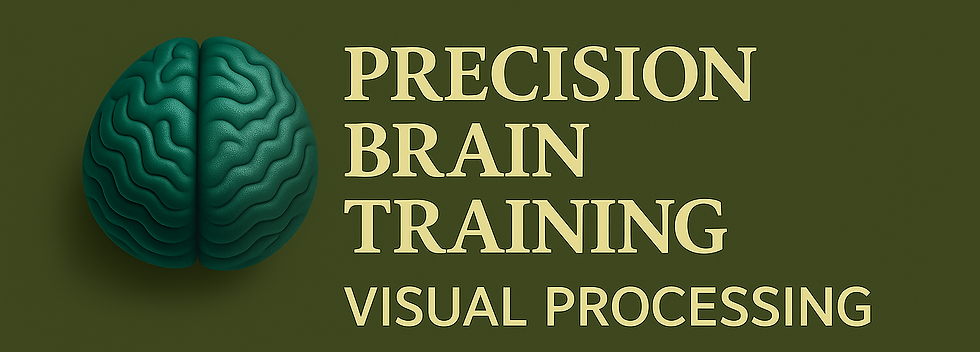
Interactive Metronome® & Visual Processing
Helping the Brain Make Sense of What the Eyes See
Is your child bright but struggling with reading, copying from the board, catching a ball, or tracking across a page?
These challenges often point to visual processing difficulties, not poor eyesight.
At Precision Brain Training™, we use Interactive Metronome® (IM) to support the brain’s ability to process, track, sequence, and respond to visual input—crucial skills for reading, writing, sports, and daily functioning.
What Is Visual Processing?
Visual processing is the brain’s ability to make meaning out of what the eyes see. Even if a child has perfect vision, they may struggle with:
-
Tracking words while reading
-
Copying from a board or book
-
Judging distance, speed, or direction
-
Locating specific details in cluttered spaces
-
Coordinating hand-eye tasks like writing or catching
These are not “vision” problems—they are brain timing and coordination issues.
Signs of Visual Processing Challenges
-
Loses place while reading
-
Avoids reading or writing
-
Poor handwriting or spacing
-
Difficulty copying accurately
-
Misjudges steps, balls, or body in space
-
Trouble with puzzles or visual memory
-
Fatigue or frustration during visual tasks
How Interactive Metronome® Helps
Interactive Metronome strengthens the brain’s timing networks responsible for processing and reacting to visual input.
By combining rhythmic movement with visual and auditory cues, IM helps improve:
Visual Processing SkillIM Support
Visual TrackingSmoother eye movement across lines or targets
Visual SequencingBetter organization of letters, words, and math steps
Visual AttentionReduced distractions and better focus on tasks
Visual-Motor IntegrationMore accurate copying, writing, catching, aiming
Depth & Spatial PerceptionSafer, more coordinated body movements in space
Brain Areas Targeted by IM
Interactive Metronome activates key regions involved in visual processing:
-
Parietal Lobes – spatial awareness and depth perception
-
Occipital Lobes – visual decoding and image processing
-
Cerebellum – movement coordination and timing
-
Prefrontal Cortex – attention and cognitive control
-
Corpus Callosum – communication between left/right brain for visual integration
These areas must work in sync for the brain to “read” and respond to what the eyes take in.
What We See Improve:
✔️ Smoother, faster reading
✔️ Better coordination and body awareness
✔️ Improved handwriting and spacing
✔️ Increased attention and visual endurance
✔️ Confidence with sports, games, and daily navigation
✔️ Fewer mistakes in copying or organizing work
Who Benefits from Visual Processing Support?
-
Children with reading difficulties
-
Students with dyslexia or ADHD
-
Kids struggling with handwriting or math
-
Children with sensory processing disorder (SPD)
-
Teens or adults recovering from concussions or brain injury
-
Anyone who has trouble organizing or responding to visual information
IM in Action at Precision Brain Training™
At our clinic, we tailor visual processing support using:
✅ IM hand and foot exercises with visual feedback
✅ Tasks requiring tracking, aiming, and timing
✅ In Motion activities to build depth and distance awareness
✅ Dual-task training: movement plus visual attention
✅ Baseline and progress tracking for visual-motor gains
Parent Testimonials
“My son used to skip lines when reading and got lost on the page. After IM, he’s reading smoother and staying on track!”
— Mom of 4th grader
“Our daughter had trouble copying from the board. Now she’s faster and more confident in class.”
— Parent of 6th grader
Train the Brain to See More Clearly
When the brain can accurately process and respond to visual input, everything becomes easier—reading, writing, focusing, playing, and learning.
Let’s Work Together
Get in touch so we can start working together.